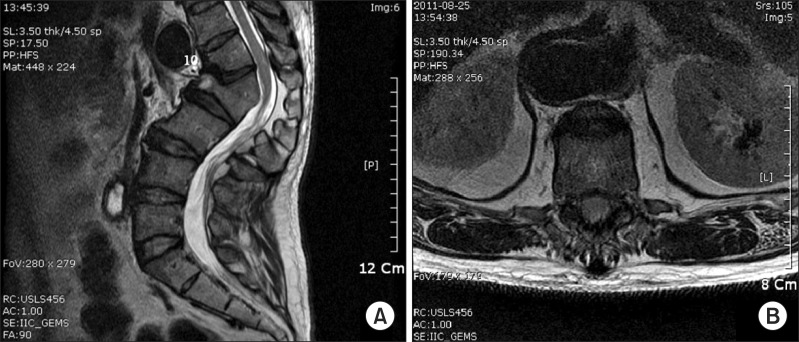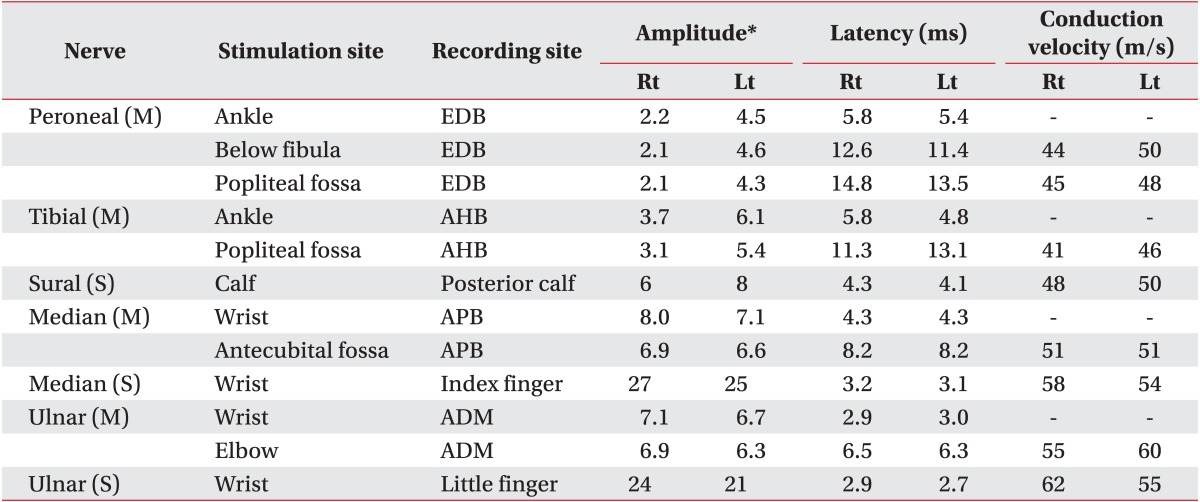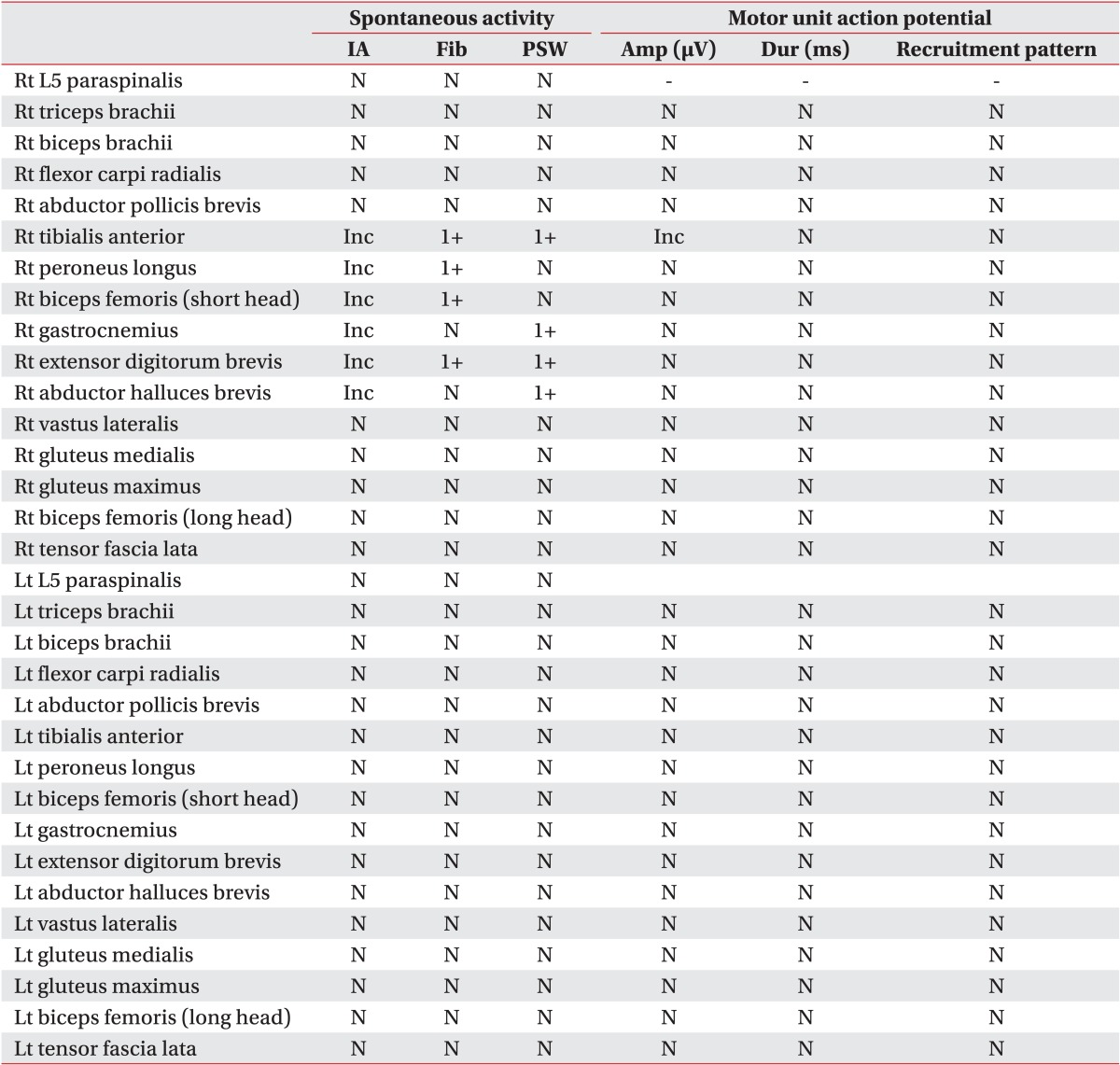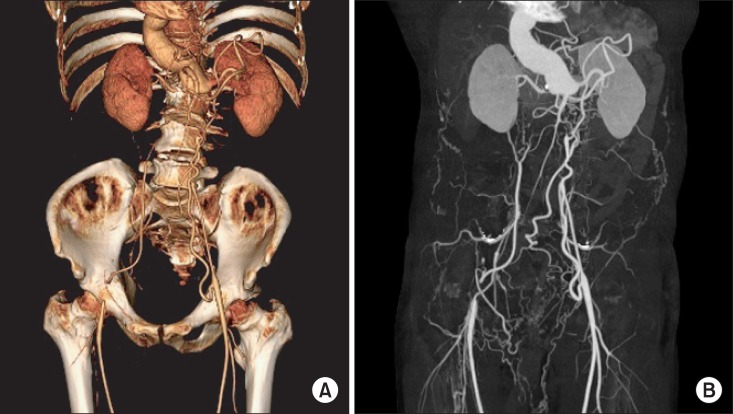This article has been
cited by other articles in ScienceCentral.
Abstract
The syndrome of aortoiliac occlusive disease, also known as Leriche syndrome, is characterized by claudication, pain, and diminished femoral pulse. We highlight an unusual case of right sciatic neuropathy caused by Leriche syndrome, which was initially misdiagnosed. A 52-year-old male, with a past medical history of hypertension and bony fusion of the thoracolumbar spine, visited our hospital complaining of right leg pain and claudication, and was initially diagnosed with spinal stenosis. The following electrophysiologic findings showed right sciatic neuropathy; but his symptom was not relieved, despite medications for neuropathy. A computed tomography angiography of the lower extremities revealed the occlusion of the infrarenal abdominal aorta, and bilateral common iliac and right external iliac arteries. All these findings suggested omitted sciatic neuropathy associated with Leriche syndrome, and the patient underwent a bilateral axillo-femoral and femoro-femoral bypass graft.
Go to :

Keywords: Leriche syndrome, Sciatic neuropathy, Spinal stenosis
INTRODUCTION
Leriche syndrome, also referred to as aortoiliac occlusive disease, is presented with the thrombotic occlusion of the infrarenal aorta [
1]. Classic symptoms include vascular leg claudication with ischemic pain, diminished femoral pulse, pallor of the lower limbs, and impotence. Vascular insufficiency of the calf or thigh can cause claudication during walking that resembles the symptoms of degenerative spinal disease. It is particularly challenging to differentiate symptoms resulting from vascular, or neurogenic claudication.
Leriche syndrome is known to cause neurologic complications, as other peripheral vascular disease does. Akhaddar et al. [
2] reported the case that Leriche syndrome caused acute paraplegia with spinal cord ischemia, due to reduced blood flow of Adamkiewicz's artery. Zankl et al. [
3] also presented the case of the patient with paresis of both legs. The patient had been admitted to the stroke unit, but was finally diagnosed with Leriche syndrome. To avoid misdiagnosis of uncommon vascular disease combined with neurologic complications, a high index of suspicion as well as more detailed history taking and physical exam, is essential.
We report a rare case of Leriche syndrome presenting as sciatic neuropathy. This case serves as a particular reminder of the importance of a complete vascular evaluation in patients with leg pain and claudication.
Go to :

CASE REPORT
A 52-year-old male with a past history of hypertension and bony fusion of the thoracolumbar spine (from 11th thoracic to 2nd lumbar vertebrae) due to tuberculous spondylitis, was presented to the department of orthopedic surgery. He was a heavy smoker and complained of right foot pain, claudication in his right calf, impaired gait functions, and muscle wasting on the right lower limb, which had begun 7 months prior to the visit.
Magnetic resonance imaging (MRI) of the thoracolumbar spine showed severe kyphotic curvature in the thoracolumbar spine, and central canal stenosis on the 10th and 11th thoracic vertebra level with a relatively well preserved lumbar spinal canal (
Fig. 1).
 | Fig. 1Thoracolumbar spine magnetic resonance imaging. (A) Sagittal view and (B) transverse view, of T10-11 intervertebral disc space on T2-weighted image show severe kyphotic curvature in the thoracolumbar spine, and central canal stenosis on the 10th and 11th thoracic vertebra level. 
|
The first impression of his attending surgeon was that he had spinal stenosis, related to severe thoracolumbar kyphosis. However, his symptoms were not well correlated to the MRI findings; and his condition did not improve, despite undergoing two weeks of medication. Subsequently, he took an electrophysiologic study at the department of neurology. The nerve conduction study revealed reduced amplitude of the right tibial and peroneal compound motor action potential, and the sural sensory nerve conduction study result was within the normal range (
Table 1). Needle electromyography showed abnormal spontaneous activities in the right tibialis anterior, peroneus longus, short head of the biceps femoris, gastrocnemius, extensor digitorum brevis, and the abductor hallucis. On volition, the giant motor unit action potential was noted in the tibialis anterior (
Table 2). These electrophysiologic findings were suggestive of partial right sciatic neuropathy. They concluded that the patient's foot pain and claudication were caused by sciatic neuropathy, combined with lumbar spinal stenosis, and maintained medication for neuropathic pain.
Table 1
Results of nerve conduction studies


Table 2
Results of needle electromyography studies


Two months later, he visited the department of rehabilitation medicine for an impairment rating and disability determination, and was still complaining of right foot pain and right leg claudication. We focused on the previously diagnosed non-traumatic right sciatic neuropathy noting his medical history; and performed an extended examination to reveal an undiscovered cause of neuropathy, or other possible causes of his symptoms. He described right leg intermittent claudication affecting the buttocks, and a burning ache radiating to the calves and foot. His claudication was exacerbated during walking and slightly relieved when resting. Upon physical examination, we were able to palpate diminished femoral and popliteal pulses on the right lower limb compared with the other side. On neurologic examination, the sensory test showed hypesthesia in the right lateral knee and foot, and sole of the foot. The motor power of the right lower limb was above grade four in all tested muscle groups, but was slightly weaker than the left side. Atrophy was also found in the right calf, anterior leg and foot muscle, and deep tendon reflexes were hypoactive in the right lower limb.
Computed tomography (CT) angiography was performed to rule out the possibility that the symptoms were caused by ischemic disease. CT angiography of the lower extremities showed an occlusion of the infrarenal abdominal aorta, and bilateral common iliac and right external iliac arteries; and collateral circulations to both the internal iliac arteries and left external iliac artery were also observed. However, there were no significant findings that could cause sciatic neuropathy, such as mass lesions (
Fig. 2). These findings were compatible with Leriche syndrome. Therefore, we concluded that our patient had Leriche syndrome causing ischemic injury of the right sciatic nerve.
 | Fig. 2Computed tomography angiography of the lower extremities. (A) 3D reconstruction images and (B) maximal intensity projection images, demonstrate an occlusion of the infrarenal abdominal aorta, and bilateral common iliac and right external iliac arteries. 
|
He was referred to the department of surgery and underwent a bilateral axillo-femoral and femoro-femoral bypass graft. After the bypass surgery, his symptoms including claudication and right foot pain were relieved; but hypesthesia and motor weakness of the lower limb arising from sciatic neuropathy persisted at the time of the last follow-up visit, 8 months after the surgery.
Go to :

DISCUSSION
The aortic occlusion of Leriche syndrome is caused by diffuse atherosclerotic changes, exacerbated by smoking, diabetes, hypertension, and hypercholesterolemia. The narrowing of the distal aorta and iliac arteries reduces blood flow to the pelvic region and lower extremities [
1,
4]. Sciatic neuropathy can result from any focal lesion of the nerve in the hip or thigh, distal to the lumbosacral plexus, but proximal to the separation of the nerve into its distal branches. Traumatic injuries occupy a vast majority of causes, and can include injury to the sciatic nerve associated with a femur fracture, hip dislocation, laceration, or posterior thigh compartment syndrome. However, there was no clinical or radiologic evidence of traumatic injury in this case; thus further evaluation was warranted to find out other possible causes [
5].
Four to eight arteries supply the sciatic nerve and they arise from the inferior gluteal, medial circumflex femoral, perforating, and popliteal arteries. The medial circumflex artery, perforating arteries, and popliteal artery are branches of the external iliac artery; while the inferior gluteal and internal pudendal arteries arise from the internal iliac artery [
6,
7]. In our patient, CT angiography revealed an occlusion of the infrarenal abdominal aorta and bilateral common iliac and right external iliac arteries. In chronic vascular occlusive disease, various collateral circulations may develop. The superior hemorrhoidal artery, intercostalis artery, and superior and inferior abdominal epigastric arteries are mainly recruited to develop collateral channels bypassing the aortoiliac arterial system in Leriche syndrome [
8]. In this case, despite the occlusion of the common iliac artery, sufficient blood flow was maintained to both internal iliac arteries by the lumbar artery, and to the left external iliac artery by the inferior phrenic artery. In contrast, the right external iliac artery did not have significant collateral circulation and this resulted in reduced blood flow to arteries supplying the sciatic nerve. It is thought this causes partial sciatic neuropathy. Furthermore, the right internal iliac artery was not able to maintain enough blood flow, because of the occlusion of the infrarenal aorta, and it might also contribute to the development of sciatic neuropathy.
Ischemic neuropathy by chronic peripheral vascular condition shows variations in pathophysiology, including demyelination, remyelination, endoneurial edema, and variable axonal changes. These variable features may be caused by the combined effects of acute ischemia/reperfusion and chronic hypoxia [
9]. It is thought that in this case, chronic hypoxia, caused by reduced blood flow to the medial circumflex artery, perforating arteries and popliteal artery, led to axonal injury of the sciatic nerve.
Our patient was first diagnosed with spinal stenosis in the department of orthopedic surgery and then the elecrophysiologic study revealed sciatic neuropathy. It took more than three months for Leriche syndrome to be diagnosed, which is the primary cause of the patient's symptoms and more serious medical issues. The delayed diagnosis can be explained as follows.
First, the patient's unilateral claudication misled physicians to have the impression of neuropathy, which commonly has unilateral symptoms [
10]. In this case, collateral circulation maintained blood flow in the left side, while both right sciatic neuropathy and vascular claudication caused by the insufficiency of right external arteries contributed to the development of the patient's symptoms in only the right lower limb.
Second, ischemic neuropathy is rarely caused by Leriche syndrome and sciatic neuropathy itself is not clinically common, and is mostly caused by a traumatic injury including fractures or complication of surgery [
5].
Another reason for the delayed diagnosis was due to the patient's past medical history and MRI findings. The previous history of bony fusion of the thoracolumbar spine (from 11th thoracic to 2nd lumbar vertebrae), due to tuberculous spondylitis and thoracolumbar spinal stenosis seen in MRI, led to the initial diagnosis of spinal stenosis, in spite of the inconsistency between the clinical symptoms and MRI findings.
As we have reviewed in this case, it might be challenging to evaluate the cause of lower limb pain in elderly patients. But, if it had been considered that lower limb pain caused by vascular problem is not uncommon in the elderly, and sufficient physical exam had been performed including peripheral pulse palpation, Leriche syndrome could have been revealed earlier. In addition, sufficient attention was not paid to finding an underlying cause of neuropathy during electrophysiologic study, even though the patient did not have a common etiology of sciatic neuropathy, such as trauma history. It reminds us that we have to pay attention to finding undiscovered causes and investigating the reasons for any mismatch between clinical symptoms and test results, when we perform electophysiologic study.
There have been few reports where Leriche syndrome caused ischemic neuropathy of the lower limb. In addition to the rarity of Leriche syndrome, most patients may have had a vascular claudication symptom and undergone surgical intervention, prior to the development of clinically significant ischemic neuropathy. To our knowledge, this was the first report presenting sciatic neuropathy caused by Leriche syndrome, and highlights the importance of the taking of a thorough history, and careful vascular and neurological examination in the diagnosis of peripheral neuropathy, for an accurate diagnosis.
Go to :






 PDF
PDF ePub
ePub Citation
Citation Print
Print





 XML Download
XML Download